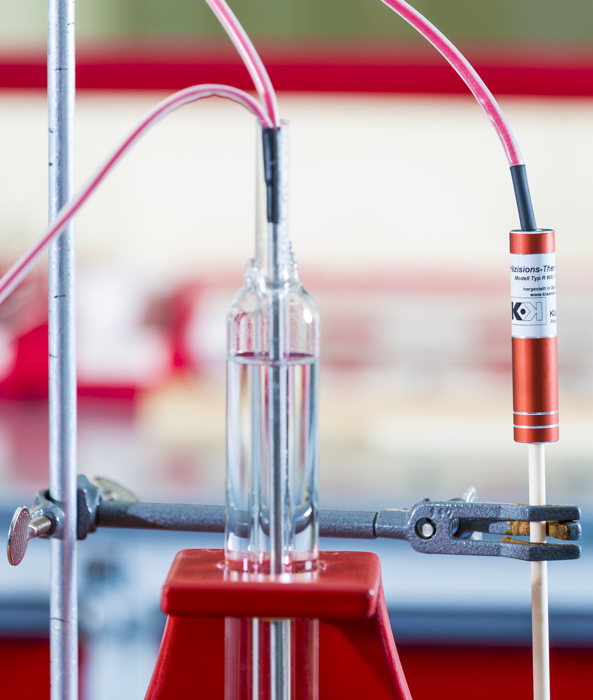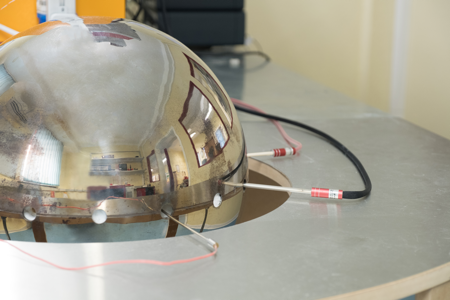
DAkkS Calibration of Thermocouples
Calibration by the comparison method or at fixed temperature points
Thermocouples are calibrated at ITS-90 temperature fixed points in the range from the water triple point to the silver freezing point with excellent measurement uncertainties. Alternatively, thermocouples in the temperature range from -196 °C to 1200 °C can also be calibrated by the comparison method (DKD-R 5-3 “Calibration of thermocouples by the comparison method”) using platinum/palladium thermocouples (Pt/Pd) or gold/platinum thermocouples (Au/Pt) as standards.
Gold/platinum thermocouples and platinum/palladium thermocouples as calibration standard
Use of state-of-the-art temperature fixed points up to the silver fixed point (961,78 °C)
Water triple points as thermocouple cold junctions
Customised calibration inserts from own production
DAkkS calibration certificate from -196 °C to 1200 °C
Temperature probes can be calibrated from a length of 190 mm
Temperature probes and indicator


Calibration of non-noble metal thermocouples
By using a variety of calibration furnaces, small immersion depths from 190mm are possible
Calibration above 0°C reference junction also possible with mini-plugs
DAkkS calibration certificate from -196 °C to 1200 °C
DKD-R 5-3 “Calibration of thermocouples according to the reference method”
Calibration of noble metal thermocouples
DAkkS calibration certificate from -50 °C to 1200 °C
Calibration at ITS-90 fixed points or alternatively as comparison calibration according to DKD-R 5-3 “Calibration of thermocouples by the comparison method”
Calibration in a 3 zone furnace with very good homogeneity

New: Inhomogeneity scan
For DAkkS calibrations of thermocouples, an inhomogeneity scan is also done. A moving heat source tests the entire thermometer material for local inhomogeneities.
The inhomogeneity scanner is an in-house development by Klasmeier. It can be used to calibrate thermocouples more precisely:
more realistic analysis of the measurement uncertainties
verification of the thermal treatment
exact statement about the homogeneity of the thermocouples

Uncertainty of measurement during DAkkS calibration
Thermocouples type Au/Pt and type Pt/Pd
| Temperature range | Procedure | Uncertainty of measurement |
|---|---|---|
| 0,01 °C | DKD-R 5-1:2018 Water triple point | 0,2 K |
| 156,5985 °C | DKD-R 5-1:2018 Indium melting point | 0,2 K |
| 231,928 °C | DKD-R 5-1:2018 Tin melting point | 0,2 K |
| 419,527 °C | DKD-R 5-1:2018 Zinc melting point | 0,2 K |
| 660,323 °C | DKD-R 5-1:2018 Aluminium melting point | 0,2 K |
| 961,78 °C | DKD-R 5-1:2018 Silver freezing point | 0,2 K |
| 0 °C to 962 °C | DKD-R 5-1:2018 in the calibration furnace | 0,4 K |
| > 962 °C to 1200 °C | DKD-R 5-1:2018 in the calibration furnace | 0,7 K |
| Temperature range | Procedure | Uncertainty of measurement |
|---|---|---|
| 0 °C to 962 °C | DKD-R 5-1:2018 in the calibration furnace | 0,4 K |
| > 962 °C to 1200 °C | DKD-R 5-1:2018 in the calibration furnace | 0,7 K |

Noble metal thermocouples
| Temperature range | Procedure | Uncertainty of measurement |
|---|---|---|
| 0,01 °C | DKD-R 5-1:2018 Water triple point | 0,2 K |
| 156,5985 °C | DKD-R 5-1:2018 Indium melting point | 0,4 K |
| 231,928 °C | DKD-R 5-1:2018 Tin melting point | 0,4 K |
| 419,527 °C | DKD-R 5-1:2018 Zinc melting point | 0,5 K |
| 660,323 °C | DKD-R 5-1:2018 Aluminium melting point | 0,5 K |
| 961,78 °C | DKD-R 5-1:2018 Silver freezing point | 0,6 K |
| Temperature range | Procedure | Uncertainty of measurement |
|---|---|---|
| -50 °C to 0°C | DKD-R 5-1:2018 in calibration furnace or liquid bath | 0,4 K ¹ |
| 0 °C to 962 °C | DKD-R 5-1:2018 in calibration furnace or liquid bath | 0,8 K ² |
| > 962 °C to 1200 °C | DKD-R 5-1:2018 in calibration furnace or liquid bath | 1,5 K ² |
² Comparison with Au/Pt- or Pt-/Pd-thermocouples.
Base-metal thermocouples
| Temperature range | Procedure | Uncertainty of measurement |
|---|---|---|
| -196 °C | DKD-R 5-1:2018 in liquid nitrogen with compensation block | 1,0 K ¹ |
| -180 °C to -80 °C | DKD-R 5-1:2018 in cryostat | 1,0 K ¹ |
| -80 °C to 230 °C | DKD-R 5–3:2018 in calibration furnace or liquid bath | 1,0 K ¹ |
| 0 °C to 962 °C | DKD-R 5–3:2018 in calibration furnace or liquid bath | 1,5 K ² |
| > 962 °C to 1200 °C | DKD-R 5–3:2018 in calibration furnace or liquid bath | 2,5 K ² |
² Comparison with standard thermocouples.


New digital archive Klasmeier Cloud:
Calibration documents quickly and easily available
The new Klasmeier Cloud – the perfect archive for all calibration documents. From now on, our customers will find a QR code on all devices calibrated by Klasmeier, with which they can quickly and easily access our digital archive.
Especially useful: In addition to all calibration documents, the contact details of the relevant contact person at Klasmeier are also always available there. So even five or more years from now, if you have any questions about your calibration product, you can find the information you need with just one click.
Finding the right calibration solution for you

Questions about our calibration services?
Please send your questions or enquiries to Mr Boris Kalb:
b.kalb@klasmeier.com
+49 661380 940-0


